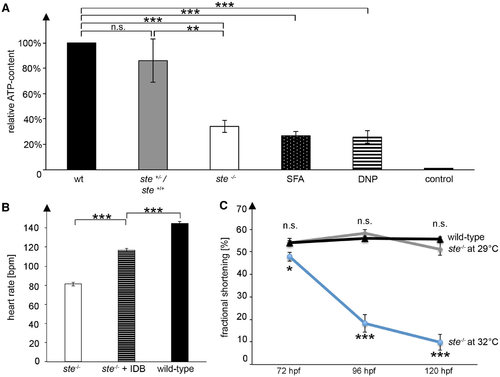Fig. 5
- ID
- ZDB-FIG-150409-25
- Publication
- Keßler et al., 2015 - Loss of dihydrolipoyl succinyltransferase (DLST) leads to reduced resting heart rate in the zebrafish
- Other Figures
- All Figure Page
- Back to All Figure Page
|
Reduced ATP levels in ste−/− mutants lead to sinus bradycardia. a ATP content of ste−/− mutant embryos is significantly reduced compared to wild-type embryos (TE strain) and wild-type ste siblings (ste+/−;+/+), whereas ATP content between TE strain and wild-type ste siblings does not significantly differ. Dead zebrafish embryos serve as a control (72 hpf). The ATP content of embryos that were incubated with SFA and DNP is also significantly reduced and resembles the ATP content of ste−/− mutant embryos. b The coenzyme Q10 analogue Idebenone partially rescues heart rate in ste−/− mutant embryos that were incubated with this drug. cste−/− mutants were incubated at increased temperature throughout embryonic development and ventricular fractional shortening was measured in wild-type and ste−/− mutant embryos at 72, 96 and 120 hpf. Fractional shortening of ste−/− mutant embryos under normal conditions (29 °C) does not significantly differ compared to wild-type embryos. Fractional shortening is reduced in ste−/− mutant embryos raised at 32 °C at (48 ± 2.1 vs. 54 ± 3.9 %, n = 10, p = 0.0358), 96 hpf (18 ± 4.0 vs. 56 ± 2.0 %, n = 10, p < 0.0001) and 120 hpf (10 ± 3.5 vs. 56 ± 2.1 %, n = 10, p < 0.0001) |
| Fish: | |
|---|---|
| Conditions: | |
| Observed In: | |
| Stage Range: | Protruding-mouth to Day 5 |

